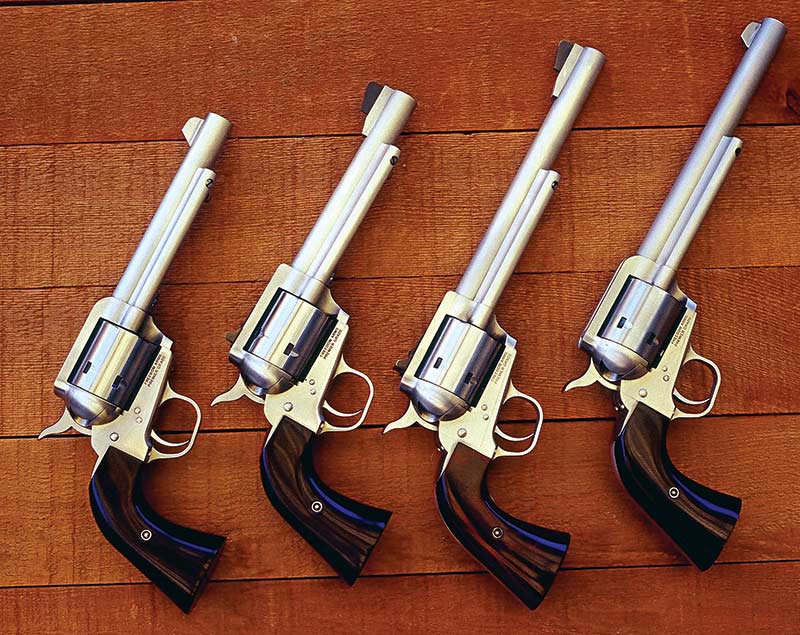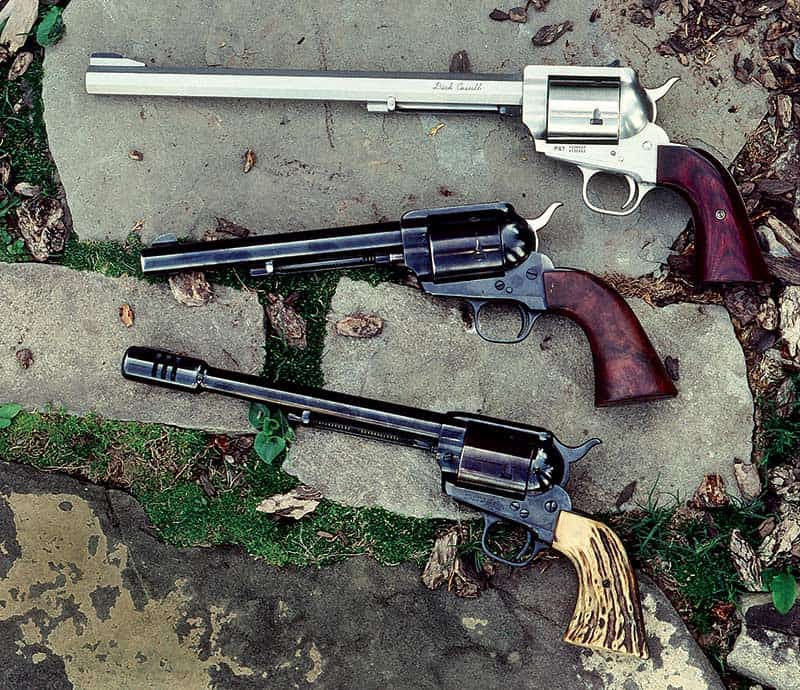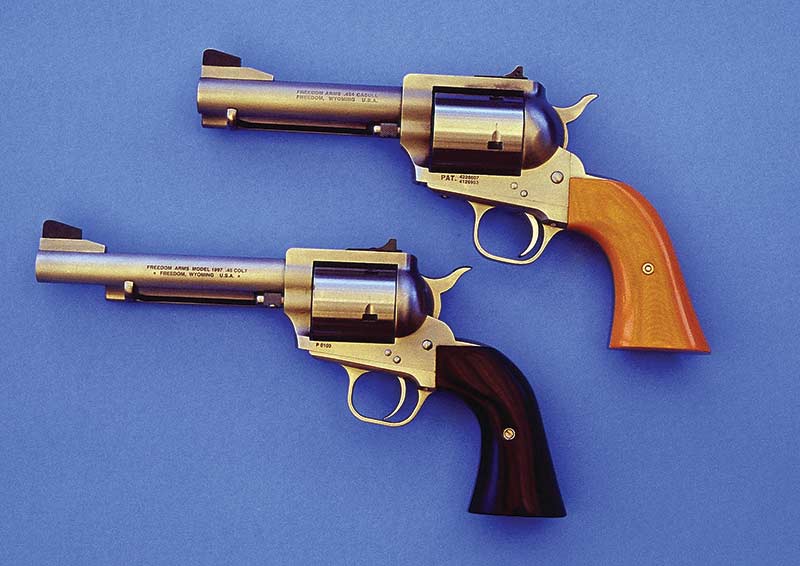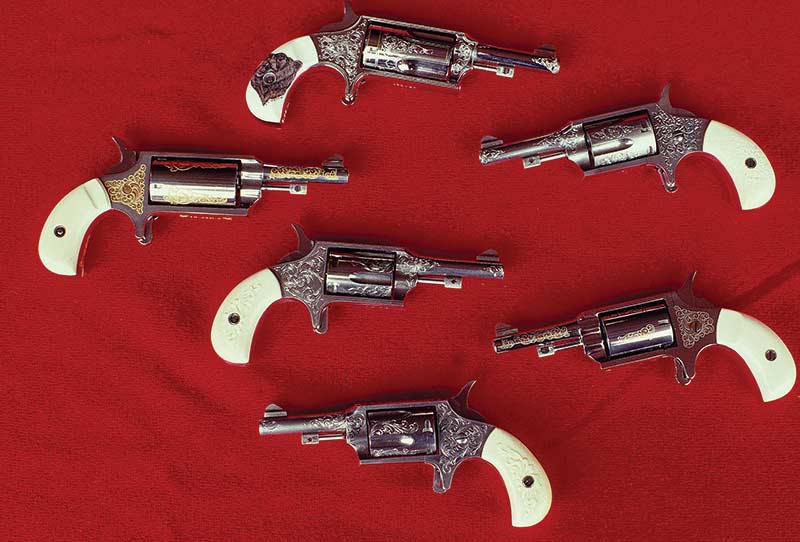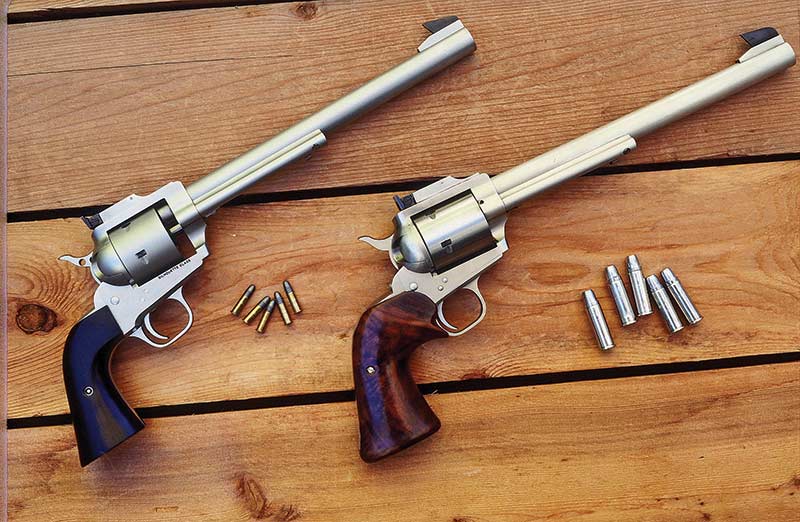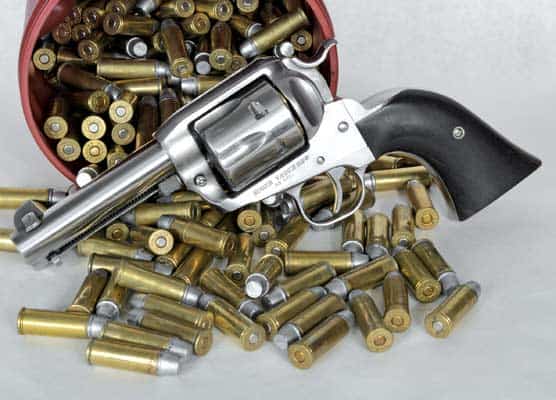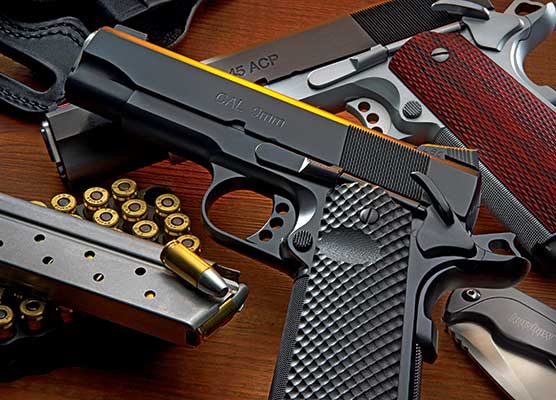Freedom Arms
25 Years Of Sixgun Perfection
In the early 1950s there was one man who did not believe the weak label attached to .45 Colt. In fact he was using .45 Colt for his experiments with high velocity sixgun ammunition. At that time .45 Colt brass had just become available with solid head construction, while .44 Special brass was still of the balloon head style. This young Utah gunsmith had a dream and a goal. The dream was to achieve 1,800 fps with a 230 grain bullet in a standard-sized sixgun while the goal was to do it safely. Had Dick Casull listened to the “experts” of the time the .454 Casull would never have arrived and Freedom Arms would not have celebrated their Silver Anniversary of building the world’s finest single action sixguns.
Casull began experimenting with his “.45 Magnum” even before the .44 Magnum arrived. He was quite limited in what revolver he could use for his special loads in that the only one suitable was the Colt Single Action. Ruger’s much stronger Blackhawk was still several years into the future. Casull discovered very early the .45 Colt cylinder would not even come close to what he was trying to achieve as he bulged many cylinders in the early stages. With heavier loads, cylinders burst and top straps blew.
Now What?
If a conventional six-shot cylinder was just not strong enough to contain the pressures, the obvious answer would be a five-shot cylinder that would give greater strength and more metal between chambers. By using 4140 steel and five-shot cylinders made as large as possible and still fit the frame window of the Colt Single Action, Casull achieved 1,300 fps with a 230 grain .45 hard cast bullet. He then turned to special heat-treating and in 1954 using a Colt Single Action .45 with an oversized five-shot cylinder, Casull hit 1,550 fps with 250 grain bullets.
Remember this is two years before the .44 Magnum and his results are 100 fps faster with 10 grains more bullet than the factory loaded .44 Magnum of 1956. Casull had the power but he was concerned about the margin of safety, so in 1957, he decided to build his own single action frame. Using 4140 steel for the frame and 4150 steel for the cylinder, the first “.454 Magnum” was created. In the early 1960s, reports of Dick Casull and his .45 Magnum started showing up in gun magazines. At the time, Casull was also converting Ruger Super Blackhawks to five-shot .45s.
Several attempts were made to turn his dream sixgun into a production revolver. It would not be until Dick Casull and Wayne Baker came together this would be realized. In March 1979 Baker and Casull began Freedom Arms, producing .22 Miniguns. Four years later, in October 1983, the first factory built five-shot .454 Casull left the Freedom Arms factory, located in the Star Valley area of Freedom, Wyoming. The .454 Casull revolver was now a reality, however it would be several years before it was widely accepted by the general shooting public.
This was also about the same time I was getting serious about a writing career. Relatively speaking, very few people in the industry knew who I was or where I was coming from. I decided to call Wayne Baker and found a most personable man who was willing to trust me with one of his expensive revolvers. He sent me a 10″ Premier Grade .454 that was soon outfitted with silhouette sights. I used it for the longrange game, switched to standard sights or a scope for hunting, and also fired thousands of heavy test loads through my first, but not last, .454.
Along the way I was able to introduce several other writers to the wonders of the .454. This test gun was subsequently purchased and today remains as tight as the day it left the factory. My first article on the .454 Casull appeared in these pages in 1986, with that article definitely helping to begin my writing career with American Handgunner. The art department did an exceptional job in laying out the first published extensive handloading information for the .454 and those pages were tacked up in reloading rooms all over the country.
The Best
From the very beginning, the Freedom Arms .454 revolver, now known as the Model 83, has been built to exacting tolerances. Cylinders are line bored (the best way) and revolvers are not assembled by reaching into a box or bin and taking out the cylinder, the frame, and the barrel and putting them together. They are in fact hand-fitted from the very beginning of mating one particular cylinder to one particular barrel and frame. Many other manufacturer’s firearms are built to a certain price level. Freedom Arms does it the opposite way, that is, they build the best possible revolver their machinery and craftsmen are capable of achieving and then set the price. That price is high, however Freedom Arms makes no apology for it and it is a rare purchaser of a Freedom Arms revolver who would say it’s not worth the price. I have yet to find such an individual.
No one ever expected to see a production revolver that would be more powerful than the .44 Magnum and to also be able to do it in such a portable package. Consider this, standard factory loading of the .44 Magnum in the 1980s was a 240 grain bullet at around 1,400-1,450 fps. Factory ammunition for the Freedom Arms five shot .454 Casull revolver consisted of bullet with a hard lead core with a heavy .032″ copper jacket. Using my 10″ .454 revolver the factory 260 grain bulleted load clocked out at 1,884 fps, and the 300 at 1,690 fps.
Using H110 I was able to duplicate both loads using the factory jacketed bullets. Dick Casull also designed two gas checked cast bullet molds especially for use in the Freedom Arms .454. With my handloads, the 260 clocks out at 1,986 fps, while the 300 breaks 1,800 fps. This is with 34.0 and 32.0 grains of H110 respectively. J.D. Jones designed a special 340 grain flat-nosed cast bullet that also achieves 1,800 fps using 32.0 grain of H110 in the same 10″ revolver. Recoil? Don’t even ask!
Times were tough for Freedom Arms in those early days. It was not easy to convince even most writers the .454 was something they even needed to look at, which helped even more to make the finest factory built revolver in a superb big game hunting chambering a tough sell for several years. Finally the word did get out and the .454 became a favorite choice of serious big game hunters. However, Freedom Arms wisely realized some diversification was necessary as everyone did not need or even want thepower of the .454, and yet many shooters had the desire to own such a masterpiece of revolver engineering and manufacturing. In February 1986 Freedom Arms offered their first Model 83 chambered in .45 Colt, followed one month later by the .44 Magnum.
Freedom .44
The Freedom Arms .44 Magnum maintained the same five-shot cylinder and line-boring operation as its older brother resulting in as-near-as-possible perfect barrel/cylinder/frame alignment. This made it nearly perfect for long-range silhouetting, and once the infamous IHMSA price ceiling rule was reversed it became a favorite on the firing line, and very quickly the revolver choice for the top shooters. As with the .454 Model 83, the specially designed grip of the .44 Magnum minimizes felt recoil as much as possible.
In the 1980s I used both the .454 and .44 Magnum 10″ Freedom Arms Model 83s for competition set up with silhouette sights. When hunting season arrived, the .454 received a change of sights for the field. I soon added two more Freedom Arms .454 and .44 Model 83s to my hunting battery, both with 71⁄2″ barrels and fitted with scope sights. The .454 was my choice for Africa, however, the .44 Magnum remains my most used hunting handgun, especially for whitetails. For game under 200 pounds I prefer the Black Hills 240 grain JHP as it is superbly accurate in my 71⁄2″ .44 Magnum and normally drops everything immediately with lung shots.
One of my most memorable hunting experiences consists of a long, steep, uphill climb in waist deep snow after a mountain lion. For this outing, I carried a 6″ iron-sighted .44 Model 83 in a shoulder holster. That mountain lion is now stretched out on a limb above my desk looking down even as I type.
A .22
As silhouette shooters began to look more and more for the best possible revolver for competition, Freedom Arms stood ready to accommodate them. In January 1991 the first five-shot .22 Long Rifle Model 83 (it was originally known as the Model 252) arrived and it quickly became the revolver of choice with the .22 silhouette shooters. The test gun I had in .22 was so accurate I hesitated to publish the results knowing that many would find it hard to believe. It was no simple matter for a .22 to make silhouette weight when chambered in the large framed Freedom Arms Single Action. The cylinder was shortened and the barrel extended back through the frame, the hammer also has four holes drilled completely through the side to help cut weight and improve lock time, and the 10″ barrel is tapered from approximately .780″ at the frame to .750″ at the muzzle end. The result is a silhouette revolver that is one ounce under four pounds.
A big game rifle that will shoot into 1″ with three shots at 100 yards is a joy; the Model 83 revolver will do it with a full cylinder of five shots. Both Winchester T22s and CCI MiniMag closely followed by the CCI Pistol Match load at 11⁄8″ and the PMC Match Rifle load at 11⁄4″. This is not from a heavy-barreled target rifle, but a revolver, a sixgun, with five separate holes that must each line up with the barrel. This is precisely why Freedom Arms are worth the cost. +V’s put five shots into 1″ at 100 yards, closely followed by the CCI Pistol Match load at 11⁄8″ and the PMC Match Rifle load at 11⁄4″. This is not from a heavy-barreled target rifle, but a revolver, a sixgun, with five separate holes that must each line up with the barrel. This is precisely why Freedom Arms are worth the cost.
The .357 Mag.
One year later, in January 1992, Freedom Arms added the .357 Magnum to the Model 83 line. Now Silhouette shooters had a superbly accurate centerfire revolver with minimum recoil. For silhouetting the FA .357 had a 9″ barrel instead of the 10″ barrel available on the .454, .44 Magnum and .22LR Model 83s to be able to make the four pound competition weight limit. Originally, as a follow-up to the .454 Casull and 252 Casull, the .357 was the 353 Casull. Now it is simply the Model 83 .357 Magnum.
However, with the .357 Magnum chambering in the Model 83, whole new vistas arrived for the original Magnum of the 1930s. How about 160 grain jacketed bullets at 1,750 fps, 180 grain jacketed bullets at 1,650 fps and 200 grain jacketed bullets at 1,500 fps? That is 400 fps faster than I can safely achieve with my pet 83⁄8″ Smith & Wesson .357 Magnum. For several decades my standard heavy .357 Magnum loading has consisted of Lyman’s #358156GC over 15.0 grains of #2400. From the 9″-barreled Model 83 the muzzle velocity is 1,640 with groups of 11⁄4″ at 25 yards, 11⁄2″ at 50 yards. Outstanding performance.
The .50 AE
In December 1993, Freedom Arms went really big bore by chambering the Model 83 (it was originally the Model 555) for the .50 Action Express. The original .50 Action Express was designed by Evan Whildin and chambered in a Desert Eagle that was a true .50, that is, the groove diameter was .510″ as were the bullets, and the bore diameter was .500″. The ATF said no, semiauto handguns may not be more than one-half inch in barrel and bullet diameter. So barrels were shrunk in diameter, and bullets are now .500″ in diameter. This means the .50AE cannot be loaded with the .510″ bullets of the .500 Linebaugh. CCI’s Lawman Factory 325 JSP clocks out of the 71⁄2″ barreled Model 83 .50AE at 1,342 fps, while my handload using the Speer 325 JHP does just a shade under 1,500 fps with 21.0 gr. Blue Dot. For cast bullets I use a 385 grain LBT flat-nose over 32.5 grains of H110 for 1,460 fps.
Even More
Freedom Arms had two more big bores to introduce in the Model 83 before the turn of the century. In December 1997, the Model 83 .41 Magnum arrived first as the Model 654. As I discussed the .41 Magnum project with Randy Smith and Bob Baker of Freedom Arms in 1996, I shared that many factory .41 Magnums would not handle heavy bullets bullets much over 220 grains, very accurately. The problem had to be barrel twist and Freedom Arms addressed this with a barrel twist of 1:14. Heavyweight bullets that used to provide shotgun style patterns at 50 yards, now will shoot in a .41 Magnum. Both the Cor-Bon 265 grain Hard Cast and the new Federal 250 grain Hard Cast factory load designed for hunting will stay right at 1″ at 50 yards. These loads are designed for the deepest possible penetration with the .41 Magnum and achieve muzzle velocities of 1,400 fps and 1,300 fps respectively.
At 100 yards Hornady’s 210 grain XTP over 22.0 grains of Accurate Arms #9 for 1,750 fps is unbelievable in its performance. The first three rounds fired from the Model 83 .41 Magnum measured 7/8″. With the next five shots, three went into 5/8″, four into 11⁄4″, and all five were a most satisfying 11⁄2″ at 100 yards. This is not only the most accurate .41 Magnum I have ever had in my hands, it is simply the most accurate centerfire revolver I have ever shot.
In April of 1999 the .475 Linebaugh arrived in a Model 83. In 1996, Freedom Arms started experimenting with one of their Premier Grade fiveshot revolvers chambered in .475 Linebaugh. It was my privilege then to fire the newest big bore but I was unable to share anything about it until they were ready to introduce it. The cylinder of the Freedom Arms features enclosed case rims so it was necessary to reduce the rim diameter of .475 cases made from .45-70 brass to fit the Freedom Arms cylinders. Naturally, Freedom Arms was reluctant to introduce their revolver in .475 Linebaugh until factory ammo was available. Once Buffalo Bore began offering a factory load for the .475 Linebaugh that had the necessary small rim, the .475 Linebaugh Freedom Arms revolver became a reality.
With Buffalo Bore’s loads, all assembled with hard cast bullets, the 420 grain LBT-LFN (Long Flat Nose) “light load” does 1,000 feet per second from a 71⁄2″ Freedom Arms .475 Linebaugh, while the full house load with the same bullet achieves 1,380, and with the 420 grain WFN (Wide Flat Nose) muzzle velocity is 1,330 fps.
Since the advent of the .475 Linebaugh in the Freedom Arms Model 83, Hornady and Ruger teamed up to produce the .480 Ruger which is nothing more than a slightly shortened .475 Linebaugh. Buffalo Bore also offers factory loaded .480 Ruger ammunition with a 420 grain bullet at 1,100 fps from a 71⁄2″ barrel. Using this load in a 43⁄4″ Freedom Arms Model 83 fitted with a .480 Ruger cylinder, I took a huge 1,200-pound trophy bison with a broadside shot at 35 yards. Penetration was complete; in one side and out the other.
Smaller/Lighter
In 1997, the Model 83 was joined by the Mid-Frame, which is now appropriately known as the Model 97. The Model 1997 is about 90-percent the size of the Freedom Arms standard Model 83, and as expected, is built to the same exacting tolerances and specifications as the original. It is slightly smaller than a Colt Single Action Army, and to me the grip frame feels much like the old Colt Bisley. The first Model 97 arrived not as the traditional Freedom Arms five-shooter, but rather a true sixgun chambered for six .357 Magnum rounds. Available with both adjustable sights for field use and fixed sights for the Cowboy Action Shooters, the Model 97 is available with standard barrel lengths of 41⁄4″, 51⁄2″, and 71⁄2″.
By August 1998, the Model 97 was unveiled as a five-shot .45 Colt. This gave us a .45 slightly smaller than a Colt Single Action with the strength of the Ruger Blackhawk. To add to its versatility, an extra cylinder is available chambered in .45 ACP. My Holy Grail is a search for what I dub the Perfect Packin’ Pistol. Of course, no such critter exists which keeps the quest interesting as we get closer and closer to perfection. The Freedom Arms Model 97 .45 Colt is about as close as we are going to come to the goal in a factory revolver.
For the true believer in the smallest of the big bores, the .41 Magnum, the same might be said for this chambering which arrived as a five-shot Model 97 in April 2000. Friend Penn Baggett, who has hosted me on many a turkey, javelina, and whitetail hunt on his ranch outside of Ozona Texas, pronounces the .41 Magnum Model 97 as the perfect ranch revolver.
The Freedom Arms Model 97 Premiere Grade chambered in .22 Long Rifle in the arrived in July 2002. In addition to the Sporting Grade cylinder, two extra cylinders are available, a Match Grade .22 Long Rifle, and a .22 Magnum cylinder. I have found that with either the Sporting Grade cylinder or the .22 Magnum cylinder, groups of less than one-third inch at 25 yards are not uncommon with the proper ammunition. This is another great little sixgun from Freedom Arms.
The arrival of the 21st century also saw the arrival of three more Freedom Arms single actions. The Model 97 .32 Magnum with an extra .32-20 cylinder has proven to be an extremely accurate and easy shooting sixgun and my hopes and prayers were answered with the advent of the Model 97 in .44 Special. Finally Freedom arms looked back at the Model 83 and chambered it in their very own cartridge, the .500 Wyoming Express.
Freedom Arms offers their Model 83 in both the Premier Grade finish as well as the matte finish Field Grade. Regardless of the finish both guns are built exactly the same way and with the same materials. The Model 97 is offered in Premier Grade finish only. There are many barrel lengths and sight options available and Freedom Arms also offers a full line of both hip and shoulder holsters with the hunter in mind.
Freedom Arms, (307)
883-2468, www.freedomarms.com.

